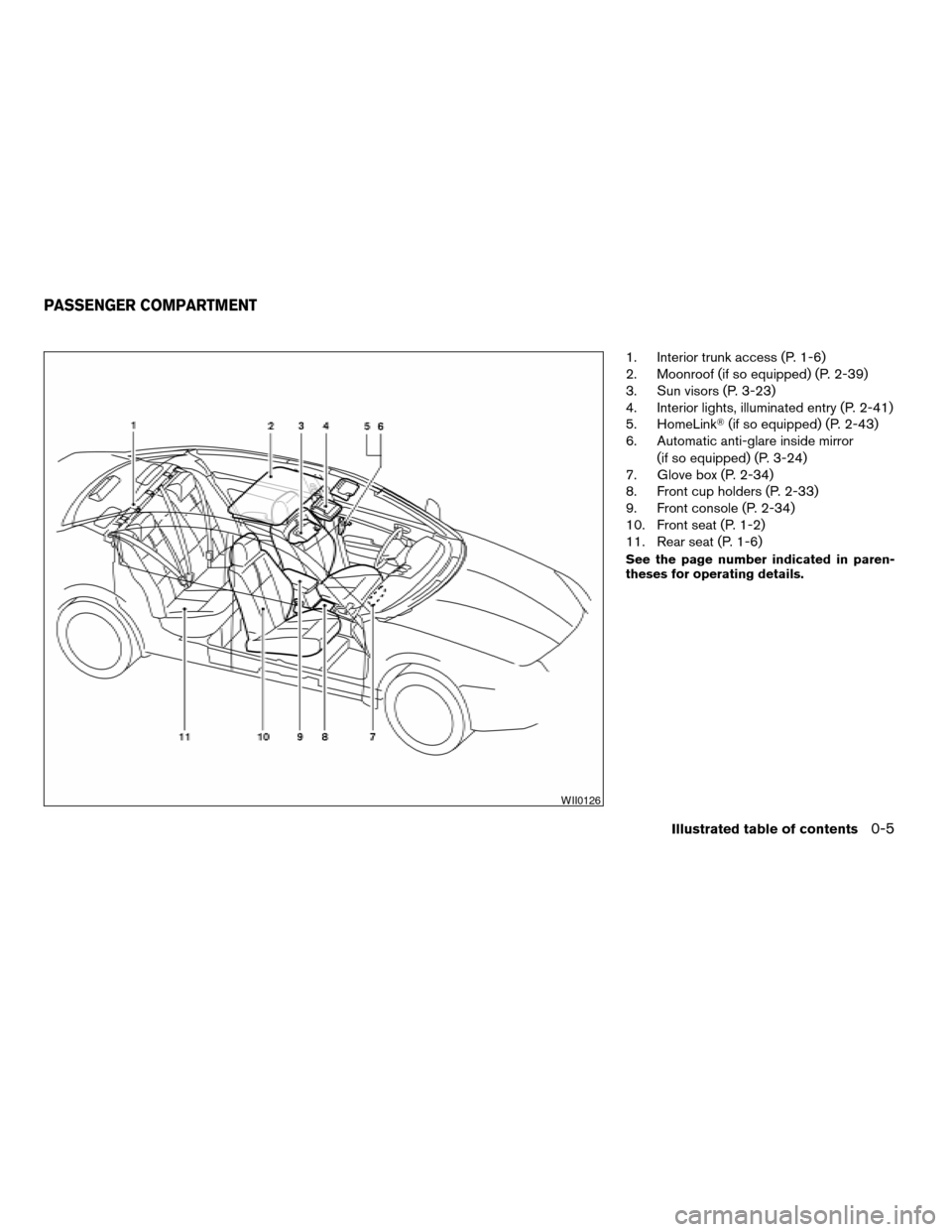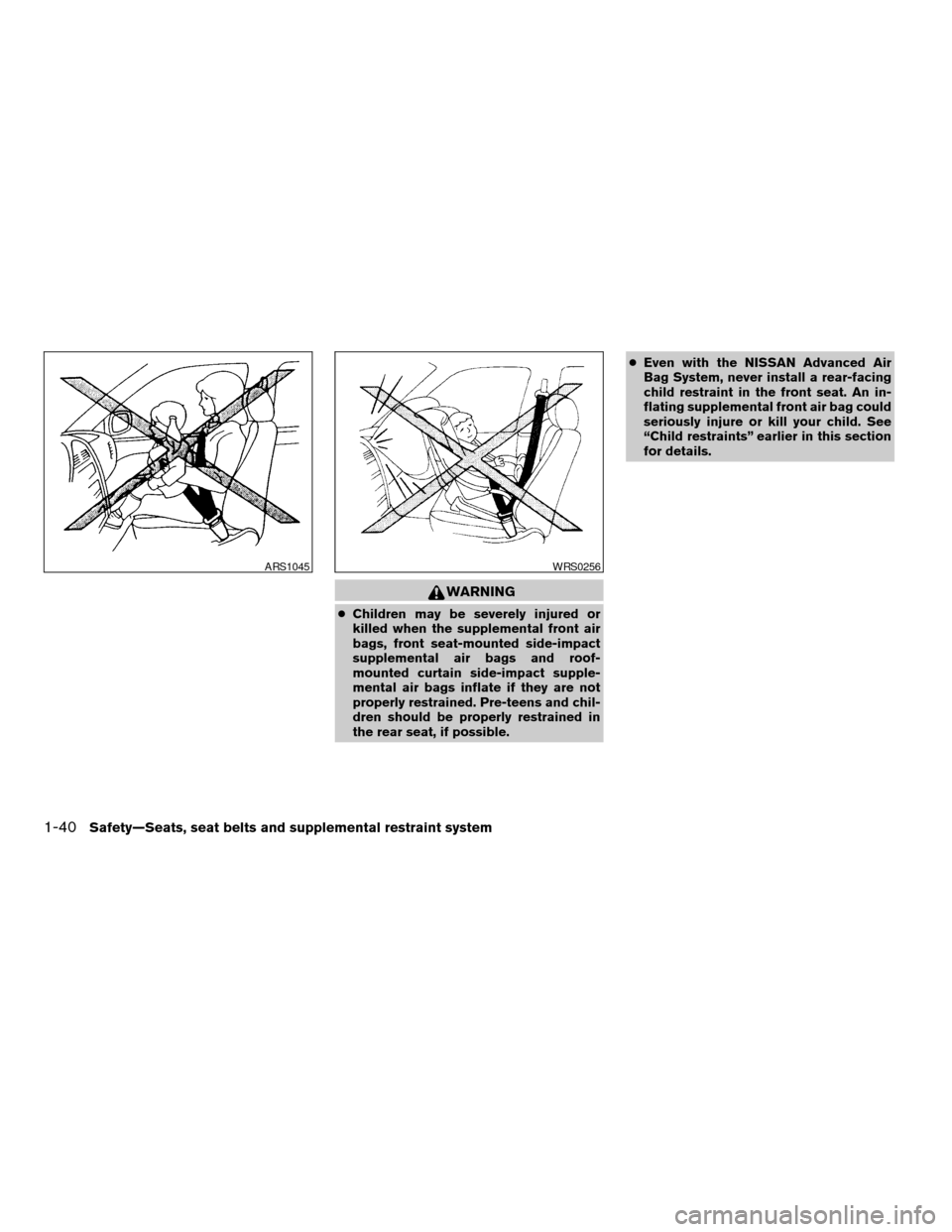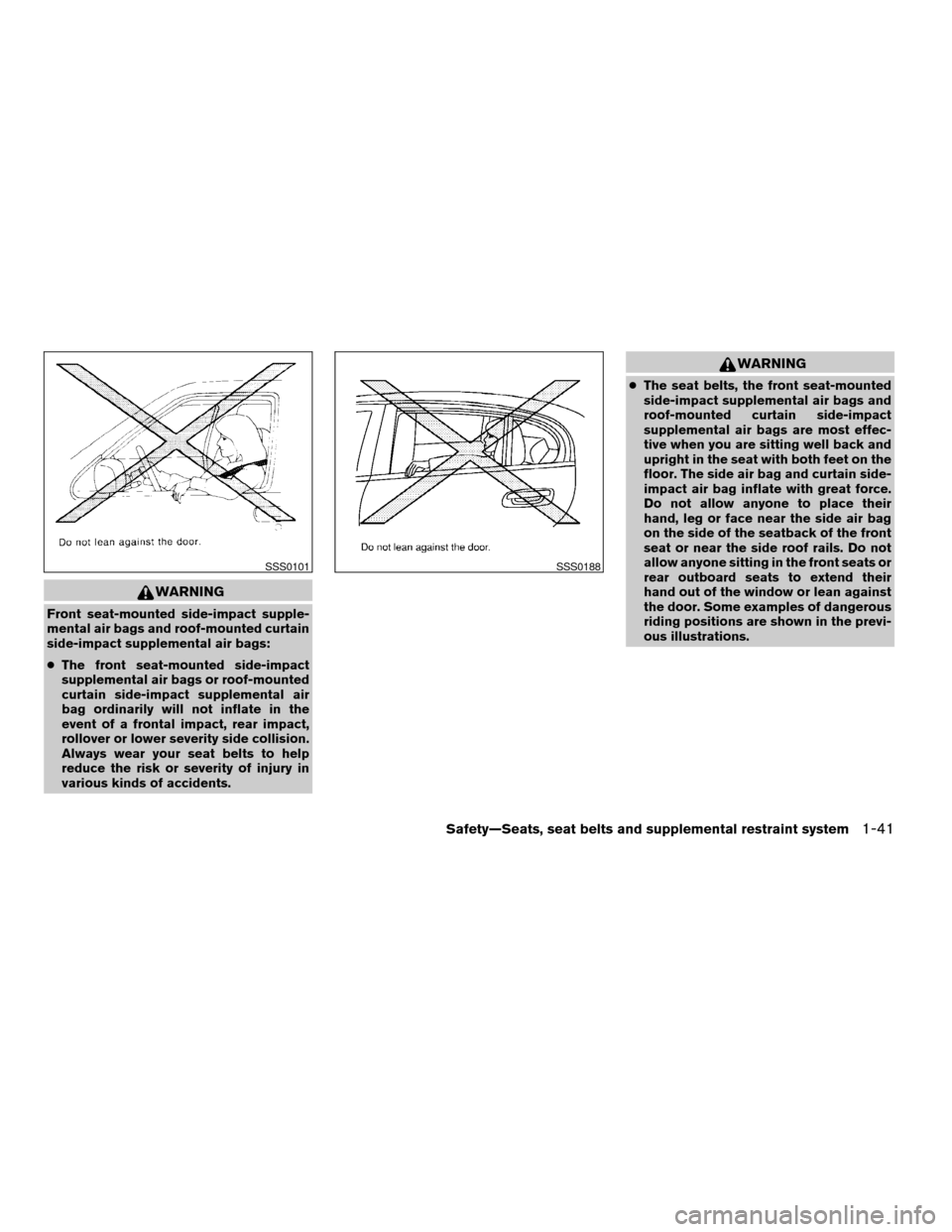2008 NISSAN MAXIMA roof
[x] Cancel search: roofPage 8 of 328

1. Top tether strap anchor (P. 1-20)
2. Rear head restraint (P. 1-7)
3. Rear seat belts (P. 1-9)
4. Roof mounted curtain side-impact
supplemental air bag (P. 1-35)
5. Front seat mounted side-impact
supplemental air bags (P. 1-35)
6. Front seat active head restraints
(P. 1-7, P. 1-8)
7. Front seat belts (P. 1-9)
8. Supplemental front impact air bags
(P. 1-35)
9. Seats (P. 1-2)
10. Occupant classification sensor
(pressure sensor) (P.1-43)
11. Seat belt pretensioners (P. 1-50)
12. LATCH (Lower Anchors and Tethers for
CHildren) (P. 1-19)
See the page number indicated in paren-
theses for operating details.
LII0065
AIRBAGS, SEAT BELTS AND CHILD
RESTRAINTS
0-2Illustrated table of contents
ZREVIEW COPYÐ2008 Maxima(max)
Owners ManualÐUSA_English(nna)
06/08/07Ðdebbie
X
Page 9 of 328

1. Engine hood (P. 3-18)
2. Headlight and turn signal switch
(P. 2-22)
3. Replacing bulbs (P. 8-29)
4. Windshield wiper and washer switch
(P. 2-20)
5. Windshield (P. 8-19)
6. Moonroof (if so equipped) (P. 2-39)
7. Power windows (P. 2-37)
8. Door locks, Intelligent key system, keys,
request button (P. 3-4, 3-6, 3-2, 3-6)
9. Mirrors (P. 3-24)
10. Tire pressure (P. 8-31)
11. Flat tire (P. 6-2)
12. Tire chains (P. 8-39)
13. Cornering light (P. 2-27)
14. Fog light switch (P. 2-26)
15. Tie down hooks (P. 6-12)
See the page number indicated in paren-
theses for operating details.
WII0086
EXTERIOR FRONT
Illustrated table of contents0-3
ZREVIEW COPYÐ2008 Maxima(max)
Owners ManualÐUSA_English(nna)
06/08/07Ðdebbie
X
Page 11 of 328

1. Interior trunk access (P. 1-6)
2. Moonroof (if so equipped) (P. 2-39)
3. Sun visors (P. 3-23)
4. Interior lights, illuminated entry (P. 2-41)
5. HomeLinkT(if so equipped) (P. 2-43)
6. Automatic anti-glare inside mirror
(if so equipped) (P. 3-24)
7. Glove box (P. 2-34)
8. Front cup holders (P. 2-33)
9. Front console (P. 2-34)
10. Front seat (P. 1-2)
11. Rear seat (P. 1-6)
See the page number indicated in paren-
theses for operating details.
WII0126
PASSENGER COMPARTMENT
Illustrated table of contents0-5
ZREVIEW COPYÐ2008 Maxima(max)
Owners ManualÐUSA_English(nna)
06/08/07Ðdebbie
X
Page 51 of 328

4. Position the lap portion of the seat belt low
and snug on the child’s hips. Be sure to
follow the booster seat manufacturer’s in-
structions for adjusting the belt routing.
5. Pull the shoulder belt portion of the seat belt
toward the retractor to take up extra slack.
Be sure the shoulder belt is positioned
across the top, middle portion of the child’s
shoulder. Be sure to follow the booster seat
manufacturer’s instructions for adjusting the
belt routing.
6. Follow the warnings, cautions and instruc-
tions for properly fastening a seat belt
shown in the “Three-point seat belt with
retractor” earlier in this section.
7. If the booster seat is installed in the front
passenger seat, turn the ignition switch to
the ON position. The front passenger air bag
status light
may or may not illuminate,
depending on the size of the child and the
type of booster seat being used. See “Front
passenger air bag and status light” later in
this section.
PRECAUTIONS ON
SUPPLEMENTAL RESTRAINT
SYSTEM
This Supplemental Restraint System (SRS) sec-
tion contains important information concerning
the driver and passenger supplemental front air
bags (NISSAN Advanced Air Bag System) , front
seat-mounted side-impact supplemental air
bags, roof-mounted curtain side-impact supple-
mental air bag and seat belt pretensioners.
Supplemental front impact air bag system:
The NISSAN Advanced Air Bag System can help
cushion the impact force to the head and chest of
the driver and front passenger in certain frontal
collisions.
Front seat-mounted side-impact supple-
mental air bag system:This system can help
cushion the impact force to the chest and pelvic
area of the driver and front passenger in certain
side impact collisions. The front seat side-impact
supplemental side air bags are designed to in-
flate on the side where the vehicle is impacted.
Roof-mounted curtain side-impact supple-
mental air bag system:This system can help
cushion the impact force to the head of occu-
pants in front and rear outboard seating positions
in certain side impact collisions. The curtain side-
Front passenger position
LRS0454
SUPPLEMENTAL RESTRAINT
SYSTEM
Safety—Seats, seat belts and supplemental restraint system1-35
ZREVIEW COPYÐ2008 Maxima(max)
Owners ManualÐUSA_English(nna)
06/08/07Ðdebbie
X
Page 56 of 328

WARNING
cChildren may be severely injured or
killed when the supplemental front air
bags, front seat-mounted side-impact
supplemental air bags and roof-
mounted curtain side-impact supple-
mental air bags inflate if they are not
properly restrained. Pre-teens and chil-
dren should be properly restrained in
the rear seat, if possible.cEven with the NISSAN Advanced Air
Bag System, never install a rear-facing
child restraint in the front seat. An in-
flating supplemental front air bag could
seriously injure or kill your child. See
“Child restraints” earlier in this section
for details.
ARS1045WRS0256
1-40Safety—Seats, seat belts and supplemental restraint system
ZREVIEW COPYÐ2008 Maxima(max)
Owners ManualÐUSA_English(nna)
06/08/07Ðdebbie
X
Page 57 of 328

WARNING
Front seat-mounted side-impact supple-
mental air bags and roof-mounted curtain
side-impact supplemental air bags:
cThe front seat-mounted side-impact
supplemental air bags or roof-mounted
curtain side-impact supplemental air
bag ordinarily will not inflate in the
event of a frontal impact, rear impact,
rollover or lower severity side collision.
Always wear your seat belts to help
reduce the risk or severity of injury in
various kinds of accidents.
WARNING
cThe seat belts, the front seat-mounted
side-impact supplemental air bags and
roof-mounted curtain side-impact
supplemental air bags are most effec-
tive when you are sitting well back and
upright in the seat with both feet on the
floor. The side air bag and curtain side-
impact air bag inflate with great force.
Do not allow anyone to place their
hand, leg or face near the side air bag
on the side of the seatback of the front
seat or near the side roof rails. Do not
allow anyone sitting in the front seats or
rear outboard seats to extend their
hand out of the window or lean against
the door. Some examples of dangerous
riding positions are shown in the previ-
ous illustrations.
SSS0101SSS0188
Safety—Seats, seat belts and supplemental restraint system1-41
ZREVIEW COPYÐ2008 Maxima(max)
Owners ManualÐUSA_English(nna)
06/08/07Ðdebbie
X
Page 59 of 328

1. Roof-mounted curtain side-impact
supplemental air bag inflators
2. Roof-mounted curtain side-impact
supplemental air bags
3. Front seat-mounted side-impact
supplemental air bag modules4. Air bag Control Unit (ACU)
5. Supplemental front air bag modules
6. Crash zone sensor
7. Occupant classification system control
unit8. Seat belt buckle switches for driver’s
and passenger’s side
9. Occupant classification sensor (pres-
sure sensor)
10. Seat belt pretensioner
11. Side satellite sensor
NISSAN Advanced Air Bag System
(front seats)
This vehicle is equipped with the NISSAN Ad-
vanced Air Bag System for the driver and front
passenger seats. This system is designed to
meet certification requirements under U.S. regu-
lations. It is also permitted in Canada.However,
all of the information, cautions and warn-
ings in this manual still apply and must be
followed.
The driver supplemental front air bag is located in
the center of the steering wheel. The passenger
supplemental front air bag is mounted in the
dashboard above the glove box. The supplemen-
tal front air bags are designed to inflate in higher
severity frontal collisions, although they may in-
flate if the forces in another type of collision are
similar to those of a higher severity frontal impact.
They may not inflate in certain frontal collisions.
Vehicle damage (or lack of it) is not always an
indication of proper supplemental front air bag
system operation.
WRS0466
Safety—Seats, seat belts and supplemental restraint system1-43
ZREVIEW COPYÐ2008 Maxima(max)
Owners ManualÐUSA_English(nna)
06/08/07Ðdebbie
X
Page 64 of 328

Front seat-mounted side-impact
supplemental air bag and roof-
mounted curtain side-impact
supplemental air bag system
The front seat-mounted side-impact supplemen-
tal air bags are located in the outside of the
seatback of the front seats. The roof-mounted
curtain side-impact supplemental air bags are
located in the side roof rails. These systems are
designed to meet voluntary guidelines to help
reduce the risk of injury to out-of-position occu-
pants.However, all of the information, cau-
tions and warnings in this manual still ap-
ply and must be followed.The front seat-mounted side-impact supplemental air bag and
roof-mounted curtain side-impact supplemental
air bags are designed to inflate in higher severity
side collisions, although they may inflate if the
forces in another type of collision are similar to
those of a higher severity side impact. They are
designed to inflate on the side where the vehicle
is impacted. They may not inflate in certain side
collisions.
Vehicle damage (or lack of it) is not always an
indication of proper front seat-mounted side-
impact supplemental air bag and roof-mounted
curtain side-impact supplemental air bag opera-
tion.
When the front seat-mounted side-impact
supplemental air bag and roof-mounted curtain
side-impact supplemental air bags inflate, a fairly
loud noise may be heard, followed by release of
smoke. This smoke is not harmful and does not
indicate a fire. Care should be taken not to inhale
it, as it may cause irritation and choking. Those
with a history of a breathing condition should get
fresh air promptly.
The front seat-mounted side-impact supplemen-
tal air bag, along with the use of seat belts, help to
cushion the impact force on the chest and pelvic
area of the front occupants. Roof-mounted cur-
tain side-impact supplemental air bags help to
cushion the impact force to the head of occu-pants in the front and rear outboard seating po-
sitions. They can help save lives and reduce
serious injuries. However, inflating front seat-
mounted side-impact supplemental air bag and
roof-mounted curtain side-impact supplemental
air bags may cause abrasions or other injuries.
Front seat-mounted side-impact supplemental
air bag and roof-mounted curtain side-impact
supplemental air bags do not provide restraint to
the lower body.
The seat belts should be correctly worn and the
driver and passenger seated upright as far as
practical away from the front seat-mounted side-
impact supplemental air bag. Rear seat passen-
gers should be seated as far away as practical
from the door finishers and side roof rails. The
front seat-mounted side-impact supplemental air
bag and roof-mounted curtain side-impact
supplemental air bags inflate quickly in order to
help protect the front occupants. Because of this,
the force of the side air bag and curtain side-
impact air bag inflating can increase the risk of
injury if the occupant is too close to, or is against,
these air bag modules during inflation. The front
seat-mounted side-impact supplemental air bag
and roof-mounted curtain side-impact supple-
mental air bags will deflate quickly after the colli-
sion is over.
LRS0259
1-48Safety—Seats, seat belts and supplemental restraint system
ZREVIEW COPYÐ2008 Maxima(max)
Owners ManualÐUSA_English(nna)
06/08/07Ðdebbie
X